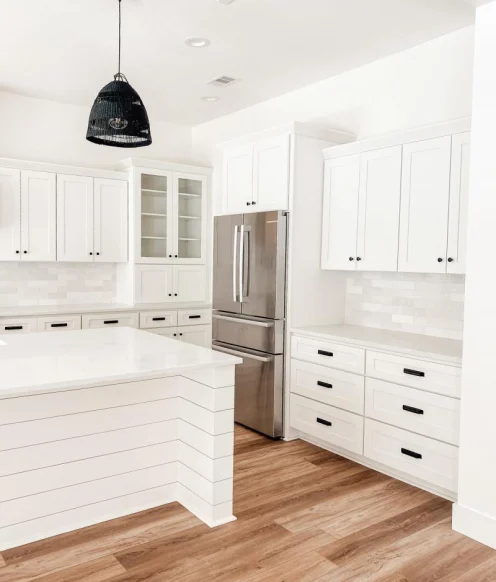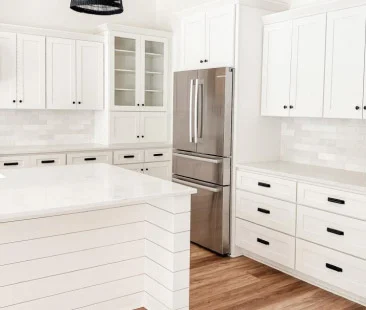Kitchen cabinets are stable and sturdy. You rely on them being able to hold heavy weights, even your full body weight if you lean or sit on them. You can cut on them, even chop meat with a heavy cleaver. Heck, you can even hammer on them while doing crafts or helping your kids with school projects, or maybe to crush up candy canes or graham crackers for a pie!
But what about cabinets you assemble yourself? Are RTA cabinets as good on stability as the kind you’d find at the hardware store, or that your contractor might install?
Sturdiness vs. Stability
There are actually two aspects to how stable a cabinet feels—the impacts it can absorb, and the weight it can hold, without rocking, giving way, or making things inside rattle. One of those is sturdiness, and while we can’t speak for all ready-to-assemble cabinets, ours are built every bit as sturdy as anything you or your contractor would find in a store.
If anything, they’re a little bit over-built, with hardwood plywood structural elements that are thicker than the industry standard. We do this partly because of our commitment to quality, but also because that makes them much less likely to be damaged during what can be some pretty novice efforts at assembly.
A professional carpenter would instinctively know not to rest an L-shaped section of a cabinet under its own weight, for example, while moving on to the next step; an inexperienced but enthusiastic DIY homeowner who maybe isn’t the best at fully reading the instructions before diving in … maybe not so much. Our cabinets are sturdy enough to stand up to even that kind of partially-assembled abuse in most cases.
Stability on the other hand, is more about installation than design. Let us explain…
There’s No Such Thing as Perfectly Flat
Even in the world of precision machining, there’s no such thing as perfectly flat. Sure, a machined part is only out of flat by a couple thousandths of an inch, but when moving into even the most finely-crafted wood, that gets a lot bigger, to hundredths or even sixteenths. Add in swelling and flexing from variation in temperature and humidity, and even the most skillfully manufactured cabinets are never going to be perfect on the top or the bottom.
And here’s another thing—floors aren’t even close to being as flat as the surfaces of manufactured cabinets. They swell and undulate more than you might imagine. This means anything with a flat bottom to support and distribute its weight, like a cabinet, is going to rock and be unstable by default. It’s why tables and most furniture have feet, not rails to support their weight.
So how do you fix that lack of stability? Shims. For every cabinet you install, you’re going to use a level to see if it’s flat, and slide shims, little wedges of wood, under the lowest parts until it is. This fact can seem a little disconcerting at first, and may be the source of the concern about RTA cabinets’ stability, but the truth is, all cabinets are shimmed.
Your contractor does the same thing. The only difference is when they do it, you don’t know about it. Then again, you also don’t know that they did it right, either … and that’s one of the great advantages of doing home improvement projects yourself!
When you order your new cabinets, don’t forget to pick up an installation kit! We have three kits ranging from just the essentials—the screws and shims an experienced DIYer would need—to kits appropriate for someone just getting started, who doesn’t own a lot of tools, and needs levels, screwdrivers, squares, wood glue, and more. Find them on our Kitchen Cabinet Accessories page as you build your order.










